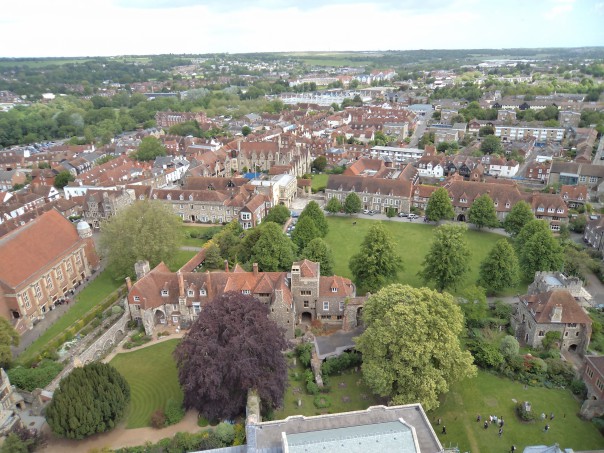The last week has brought to light some fascinating discoveries. Firstly it was great to hear about the uncovering of Sandwich’s own copy of the Magna Carta that was unearthed in the town’s collection at Kent History Library Centre by Dr Mark Bateson. Dr Bateson, as an accomplished Latin scholar and archivist, is a great asset to the county’s archive service and thus it is not surprising that he was able to identify this charter even though it is in a poor condition. For as I noted last week literacy and civic record keeping were major features of medieval Cinque Port society and this discovery fits very neatly into the history of developing self-government at Sandwich from the reign of Edward I that Dr Justin Croft discussed in an article in Archaeologia Cantiana (1997).
View from Bell Harry
This fitting together of the pieces of the jigsaw from the archives to provide a better understanding of the past can also be seen in Professor Jackie Eales’ exposition of the career of Elizabeth Elstob (1683–1756), a writer who spent much of her childhood in the precincts of Canterbury Cathedral in the household of her uncle the Rev. Charles Elstob. Her love of learning was apparently fostered by first her mother, then as an orphan by her aunt and uncle, before she joined her brother while he was studying at university and finally at his clerical living in London. As a result she became an expert in French, but far more importantly in Anglo-Saxon which for a woman was a remarkable accomplishment at a time when women’s education was seen as an exceedingly low priority by society. Even though she was justly celebrated during her lifetime, having a considerable number of prominent aristocrats among her patrons, including Robert Harley, the 1st Earl of Oxford (whose collection of manuscripts will be well known to users of the British Library), she was later largely forgotten and thus it is great to hear about Professor Eales’ rehabilitation of her and her pioneering scholastic work on the Anglo-Saxon language – this nation’s mother tongue.
I learnt about Elizabeth Elstob at Professor Eales’ lecture on Wednesday evening to Canterbury Historical and Archaeological Society and this inter-relationship between town and gown is a vital part of the Centre for Research in Kent History and Archaeology’s activities. Moreover this is a two-way process, because questions and comments from members of the audience drew out, for example, the importance of clerical links to several prominent Huguenot families within the Canterbury precincts under the later Stuart monarchs. Several members of this audience were similarly present at another meeting of city and university, although this time ‘up the hill’ at Kent’s Medieval and Early Modern Studies research seminar. Again past members of the cathedral community featured heavily, but this time as the protagonists in what has come to be known as the Prebendaries’ Plot of the early 1540s. This plot by the religious conservatives to oust Archbishop Cranmer is especially interesting for the wealth of material uncovered in the Archbishop’s subsequent investigations, which highlighted the polarised nature of the cathedral community between the conservatives and the radicals. Furthermore, such divisions were equally visible across the Canterbury diocese, particularly in certain ‘hotspots’ such as Lenham and surrounding parishes, Sandwich and its immediate hinterland and a cluster of Canterbury parishes. I’ll select just one example to give you a flavour of this religious turbulence and it concerns the activities of Alderman John Toftes in his home parish of St Mary Northgate. This church that once spanned Canterbury’s Northgate (or at least what remains of it) is now owned by Kings and some of you may have attended plays there. The drama involving John Toftes may have been equally riveting for his audience because he was said, by the conservative witnesses, to have read in the church ‘openly and with lowde voice’ the Bible (in English) to several women, including his wife and the local midwife. Presumably the Bible in question was Henry VIII’s and Cranmer’s ‘Great Bible’ that all parishes had been directed to purchase, and because this would have been the responsibility of the churchwardens rather than the incumbent, Toftes and his fellow reformers were in a sense able to taunt the deeply conservative vicar through their possession and use of the Bible in the nave – lay space within the church.
All three of these examples for this week would seem to highlight just how interesting history ‘from below’ can be. Although much is made of the grand history of kings and queens on TV, in books and on history courses, and I’m not decrying its worth, there are other ways of exploring a society’s history, as Michael Wood to a degree did in his account of Shakespeare’s mother last night. And speaking for myself I would want to extend this further, to men such as John Toftes and even further down the social scale to Thomas Makeblyth, a Canterbury barber, whose commitment to ‘Protestantism’ was so strong that he was prepared to risk censure from his fellow parishioners by refusing to process carrying a palm on Palm Sunday and instead read the Bible, and then the following Sunday again refused to process and went into a corner. Even though these men will not feature in the ‘New Developments in Kent History’ conference at Christ Church next month, their counterparts in early modern Kent will be there, men who objected to paying tithes to lay farmers or who sought to get an education for their sons so that they could make a good living in the changing times of Tudor England.
 Centre for Kent History and Heritage
Centre for Kent History and Heritage Sheila Sweetinburgh
Sheila Sweetinburgh 755
755


